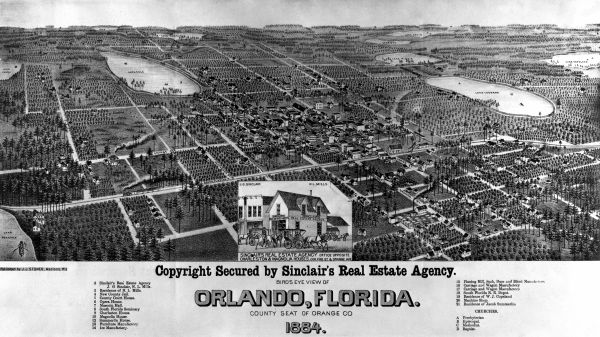
Introduction1920s OrlandoHistory of Avalon GrovesAvalon Groves Shareholders
Land of Avalon GrovesCitrus of Avalon GrovesAvalon Groves Crate Labels
BibliographyCredits
Orlando During the 1920s
After the Civil War, Florida’s peninsula was still a sparsely populated frontier zone. In the late 1800s it was developed by Northern capitalists by means of the railroads. Starting in the 1870s and 1880s, Florida’s boosters went out of their way to promote their state’s sunshine and balmy climate to winter-weary Northerners in the hope of exploiting tourism dollars. The Dixie Highway was built between 1915 and 1927 to connect Florida with Chicago and the Midwest and bring those tourists to the state.
The 1,350 miles of coastline in Florida means it has a semi-tropical climate that is nearly frost free in much of the state. The citrus industry shifted further south after hard freezes devastated the old citrus belt in North Florida in 1894-1895; and Central and South Florida began to grow winter vegetables for the Northern market after the railroads penetrated the region. Tourism and Citrus formed the basis for the creation of the Lake Avalon Groves venture.
In the 1920s Florida was the focus of one of the greatest economic and social phenomenon in American history as hundreds of thousands of Americans of all types of financial strata poured into the State and forever changed the global image of Florida. Two important elements played roles in the Florida Land Boom. For the first time Americans had the leisure time to travel, and money to invest in real estate. For the educated and skilled working American, the 1920s meant paid vacations, pensions, and fringe benefits unheard of before. The United States also had the automobile and a growing road system, in addition to train lines that were being built.
Despite the great publicity, there was evidence that the Florida Land Boom was on swampy ground. Forbes magazine warned that Florida land prices were based solely upon the expectation of finding a customer, not upon any reality of land value. New York bankers, losing money over Florida investment, attacked the entire operation as one great sham. By 1925, there were other signs. Companies were laying off construction and other blue collar workers while the number of realtors and auto mechanics was still increasing. While Orlando has experienced a land boom, the bust was coming quickly.
